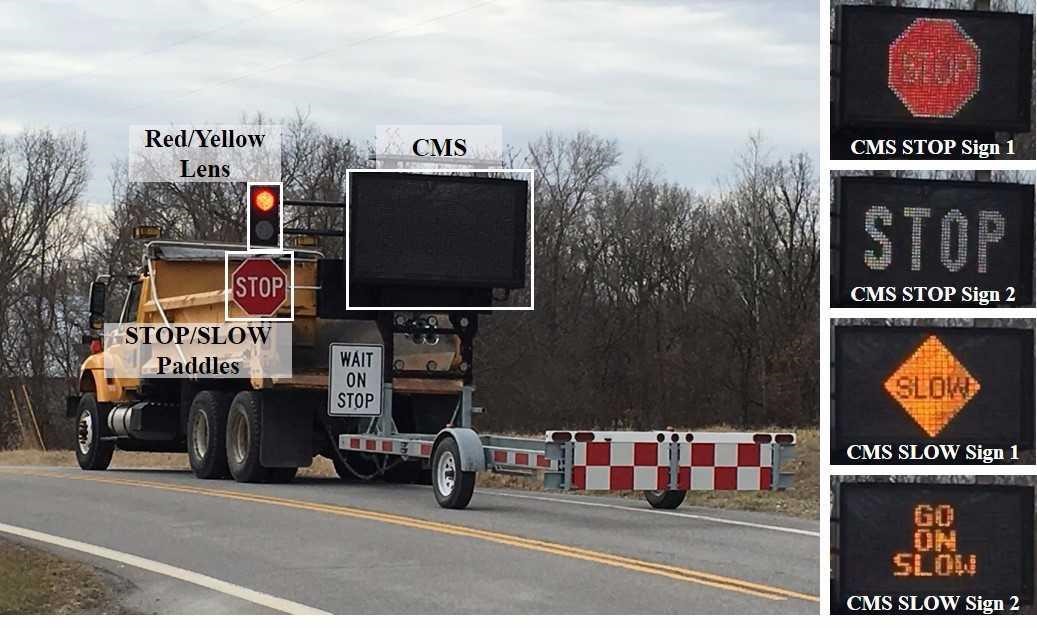Field Testing of an Automated Flagger Assistant Device in Missouri Reduces Vehicle Approach Speeds by Four Miles Per Hour and Increases Stopping Distance by 11 Feet.
Field Testing and Driving Simulation of an Automated Flagger Assistant Device Reveals Safety Benefits in Work Zones.
Lone Jack, Missouri, United States
Knob Noster, Missouri, United States
Evaluation of Automated Flagger Assistance Devices
Summary Information
This study evaluates the Automated Flagger Assistance Device (AFAD) developed by the Missouri Department of Transportation (MoDOT) via a combined field study and driving simulator tests performed in 2017. The MoDOT AFAD configuration, involving STOP/SLOW paddles, red/yellow lights, and a changeable message sign (CMS), was incorporated onto a truck-mounted attenuator for operator protection. After conducting the field tests, a driver simulator was utilized to examine various details of the AFAD design in a cost-efficient manner since AFAD variations were implemented in a virtual world. Both the field test and the simulator study were followed by surveys that captured driver preferences and comprehension.
Methodology:
For the field study, video data that recorded driver behaviors was collected for two days in a work zone on MO 23 in Knob Noster, Missouri. Seven Measures of Effectiveness (MOEs) were evaluated, including speed of the leading vehicle at 250 ft. from the AFAD/Flagger, full stop location, waiting time, reaction time, intervention rate (the percentage of drivers not obeying the flagging instructions), speed of the 1st following vehicle, and queue length.

For the driving simulator, a medium-fidelity simulator built around the half-cab of a sedan simulated work zones on a rural highway in Missouri. This simulator study explored four flagging methods: (1) human flagger, (2) MoDOT AFAD, (3) a variation on method 2 with an alternative sign, and (4) a variation on method 2 with the CMS turned off. Five MOEs were extracted from the video of each participant trial: approach speed, full stop distance, reaction time, intervention rate, and first brake location (the location at which the driver first pressed the decelerator pedal in reaction to the flagger/AFAD).
A total of 42 responses were received for the field study survey and 32 responses were received for the driving simulator survey.
Findings:
- In the field study, the AFAD induced slower vehicle approach speeds (4.20 mph less), shorter waiting times (33 seconds less), quicker traffic release (1.28 seconds less) and stopped vehicles farther back (11.40 feet) than flaggers. The intervention rate for AFAD was 0.004 lower than flagger, but the difference was not statistically significant. With the AFAD, the approaching speeds for the 1st following vehicles were significantly slower than without the AFAD (2.46 mph less).
- In the driving simulator study, the AFAD induced slower vehicle approach speeds (8.44 mph less), lower intervention rate (0.14 lower) and stopped vehicles farther back (44.46 feet). The first brake location for MoDOT AFAD was significantly farther away (58.17 ft), which indicated that the MoDOT AFAD was more visible than the human flagger, and the MoDOT AFAD clearly conveyed the STOP message to drivers.
- In the driving simulator study, the alternative designs of AFAD (AFAD with an alternative sign and AFAD without CMS) also significantly reduced average approach speeds (7.7 to 8.9 mph) and increased the distance at which the approaching vehicles came to a complete stop (21 to 38 feet). The results from both the field and the simulator study surveys showed that the MoDOT AFAD was preferred over the flagger (78 percent of the field participants preferred the AFAD more or much more than flagger, and simulator participants rated AFAD the most preferred among the four designs).
- The MoDOT AFAD had significantly lower scores in clarity, visibility, safety, and efficiency, than the AFAD without CMS and the human flagger and the AFAD with alternative sign scored the second highest in all categories.
- A majority of both the field and the simulator study survey respondents (78-90 percent) thought that the CMS was necessary/helpful, though the AFAD with CMS scored significantly lower in visibility and safety than the MoDOT AFAD.
